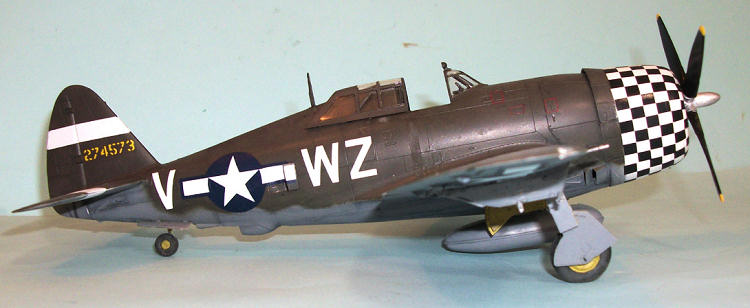
Tamiya 1/48 P-47D Thunderbolt
| KIT #: | 61086 |
| PRICE: | $49.95 |
| DECALS: | Two options |
| REVIEWER: | Tom Cleaver |
| NOTES: |

The 78th
Fighter Group:
The 78th PG
became the 78th Fighter Group in
May 1942 with the change in AAF designations, based at Hamilton Field north of
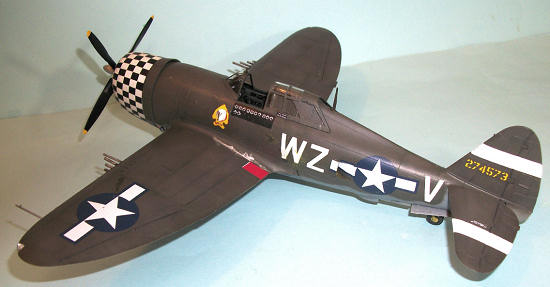 In June, the four P-38 groups began movement to
In June, the four P-38 groups began movement to
By January, however, the three P-38 groups in
When the first P-47s arrived at Goxhill, the pilots were
amazed at its size, and also took note of the very strongly worded instructions
in the Pilot’s Notes about not initiating a steep dive above 23,000 feet.
On February 6, Captain Herb Ross took one up for a check
ride. Climbing to 35,000 feet, he pushed over to see what the problems were.
Speed built rapidly; at 27,000 feet, Ross experienced
tail buffet so intense the stick flailed out of his hands.
Grabbing the stick as he sped through 20,000 feet, the
controls felt ‘set in concrete.’
He began feeding in nose-up elevator trim.
As he passed through 10,000 feet, certain his time had
come, the racket stopped, the nose gradually came up and the Thunderbolt leveled
off at 5,000 feet.
Ross called to ask whether he should land the damaged
airplane or bail out.
Told to bring it in to have a look, he was so shaken he
had to be helped from the cockpit on arrival.
A short inspection certified the airplane ‘Class 26,’
damaged beyond repair.
The paint was off the leading edges of all flying
surfaces; wing spars had been pulled back and the sheet metal failed at the wing
roots; vertical and horizontal stabilizers were pulled back with root failure,
and most of the fabric on the elevators was hanging in tatters.
As Dayhuff recalled, ‘It was the sickest looking
lately-new P-47 one can imagine, having only collided with air.’
Ross gained the nickname ‘Rocket’ from the incident. The
pilots now understood the P-47 was as dangerous as a P-38 when it came to the
little-understood problem of “compressibility.”
Fortunately, metal elevators soon arrived to replace the
fabric elevators on the P-47C-2s, and all subsequent P-47s arrived so equipped.
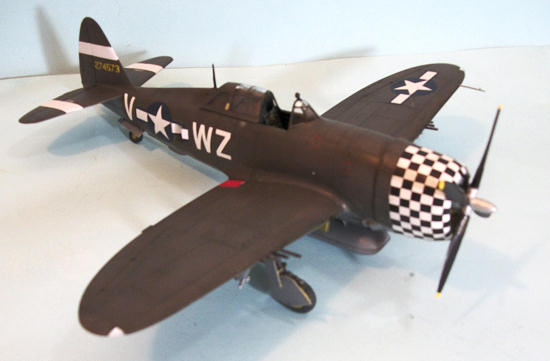 The 78th
began receiving RAF-trained American pilots who had transferred to the AAF in
late February.
Group Commander Col. Arman Peterson and his squadron leaders
managed to learn enough about the P-47 to get things moving.
The 78th
moved from Goxhill to Duxford in late March.
Every man who ever served in the group remembered the
steam heat of the permanent RAF base and the fact that only the 4th
lived better than they did.
Huie Lamb recalled that “Compared to everything else in
the Eighth, we lived in a country club.”
The 78th
began receiving RAF-trained American pilots who had transferred to the AAF in
late February.
Group Commander Col. Arman Peterson and his squadron leaders
managed to learn enough about the P-47 to get things moving.
The 78th
moved from Goxhill to Duxford in late March.
Every man who ever served in the group remembered the
steam heat of the permanent RAF base and the fact that only the 4th
lived better than they did.
Huie Lamb recalled that “Compared to everything else in
the Eighth, we lived in a country club.”
84th
Squadron CO Major Gene Reynolds decreed all airplanes of the 84th
would be polished with beeswax to improve airspeed.
As Sergeant James Tudor remembered, “It was great fun to
forget about the wax and slip, then fall off the wing with a full tool box or
take off the big heavy section of the bottom cowl and have it slip and come
crashing down on your foot.
I believe it gave a whole two to five mile an hour
increase in speed.”
The first combat missions were flown in April, with each
of the three squadrons, the 82nd,
83rd and 84th
making missions with the 4th on
coastal sweeps.
In late April, the first AAF-trained pilots trained on
the P-47 arrived to flesh out flight personnel.
Among them was an older 1st
Lieutenant who had been a flight instructor for the previous year; only Col.
Peterson had been in the AAF longer than Quince Brown, who had more flight
experience and more P-47 experience than any of the group leaders did.
He was assigned to the 84th
Squadron, where Gene Reynolds quickly promoted him to flight leader. Ernie
Russell, who would later fly as wingman and element leader to Brown remembered,
“He could joke and had a little smile, but he was not brash or loud; however,
you knew that he meant what he said and, if tested, would tell you what he
thought, never loudly, but as matter of fact.
He was not prone to jest, but he did have a good sense
of humor.
Above all he was not a braggart; it just wasn’t in his makeup.
He was known by all in the squadron as one of the best
pilots, though he would never tell you that —
like a cowboy, ‘the
proof was in the pudding.’
He had excellent vision - better than mine, and I had
20/10 vision - good peripheral vision that is essential to seeing movements in
the sky, and good judgment.
All that combined with the fact that he was an excellent
shot made him a superb fighter pilot.”
Born in 1917 in Hydro, Oklahoma, he was the fifth of
five sons, hence his name.
From letters home preserved by his family, Brown reveals
intelligence and that dry sense of humor often found in Oklahomans.
In May 1943 the 78th
began flying missions as a group.
They quickly ran into the Luftwaffe.
On May 15, the first three victories were scored.
Two of the three victorious pilots were in turn shot
down, one of them being Captain Elmer “Mac” McTaggart.
He managed to evade the Germans and was put in touch
with the local Resistance.
After two days of relentless German searches, he was
dressed as a Basque peasant, given a bicycle, and told to head south to the
Pyrenees.
McTaggart took two weeks, traveling on back country roads through
western France, to get to the border, where he was able to contact the people
whose names he had been given.
Taken up to the border, he crossed into Spain.
At the first village, he used the phone number he had
been given to contact the American embassy in Madrid.
The Guardia Civil
arrived to collect him and tossed him in jail.
Ordinarily, an evader might spend 4-6 weeks in jail
awaiting release to the embassy. McTaggart was in a cell with men who had
already done that and the next day everyone was collected and sent to Madrid.
By June 18 they were in Gibraltar awaiting a flight back
to England, where McTaggart arrived on June 23, five weeks after his bail out.
It was the 8th
Air Force record for evasion.
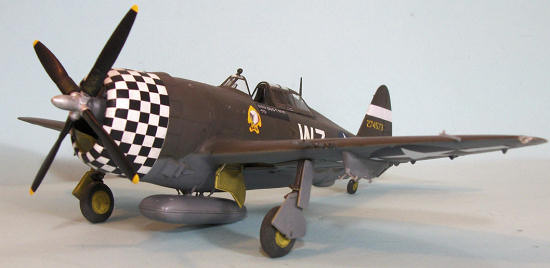 On July 1, Col. Peterson was killed in combat over
Holland.
Two days later, Bob Hope arrived with his USO tour.
As Hope later recalled, “they were the toughest house I
played in the entire war.” The 8th
AF finally felt capable of attempting a sustained campaign, and the month was
spent on the “Little Blitz.”
On July 30, the 78th
made their first mission using unpressurized ferry tanks.
Helped by a tailwind and crossing into Holland at a
lower altitude so they could keep the tanks, the group was able to cross the
German border and rendezvous with the 165 B-17s returning from bombing the
Focke-Wulf factory at Kassel. They
were 50 miles east of the furthest penetration yet made by American fighters,
and they caught the attacking Luftwaffe
fighters by surprise.
In ten minutes’ combat, 16 German fighters were shot
down for a loss of two P-47s.
Captain Charles London scored two to become the first 8th
AF ace, while Gene Reynolds scored the first triple, and Quince Brown shot down
his second.
It was the most important air combat in the history of 8th
Fighter Command: for the first time, American fighters had taken on the
Luftwaffe at maximum range and scored decisively.
Returning from combat at low level, Quince Brown became
the first 8th AF pilot to strafe a
target, taking out the first of hundreds of trains that would fall victim to
P-47s in the next 21 months.
On July 1, Col. Peterson was killed in combat over
Holland.
Two days later, Bob Hope arrived with his USO tour.
As Hope later recalled, “they were the toughest house I
played in the entire war.” The 8th
AF finally felt capable of attempting a sustained campaign, and the month was
spent on the “Little Blitz.”
On July 30, the 78th
made their first mission using unpressurized ferry tanks.
Helped by a tailwind and crossing into Holland at a
lower altitude so they could keep the tanks, the group was able to cross the
German border and rendezvous with the 165 B-17s returning from bombing the
Focke-Wulf factory at Kassel. They
were 50 miles east of the furthest penetration yet made by American fighters,
and they caught the attacking Luftwaffe
fighters by surprise.
In ten minutes’ combat, 16 German fighters were shot
down for a loss of two P-47s.
Captain Charles London scored two to become the first 8th
AF ace, while Gene Reynolds scored the first triple, and Quince Brown shot down
his second.
It was the most important air combat in the history of 8th
Fighter Command: for the first time, American fighters had taken on the
Luftwaffe at maximum range and scored decisively.
Returning from combat at low level, Quince Brown became
the first 8th AF pilot to strafe a
target, taking out the first of hundreds of trains that would fall victim to
P-47s in the next 21 months.
In September, the group received 108-gallon paper tanks,
were able to penetrate 200 miles into Germany with ten minutes’ fuel for combat
carrying one tank on the centerline.
On September 27, 45 Thunderbolts led by Harry Dayhuff
headed for rendezvous ten miles west of Emden.
They arrived at the rendezvous to find 30 Bf-109s making
rocket-firing passes as two huge fireballs fell away from the U.S. formation.
The Germans had no expectation of meeting American
fighters, and the 78th hit them
hard, shooting down 8 including Quince Brown’s fifth.
With the Germans broken up in the five minute fight, the
Thunderbolts regrouped and stayed with the bombers, beating off attacks until
fuel forced them to depart 40 miles off the Dutch coast.
Following the German defeat of the 8th
Air Force at Schweinfurt on October 14, weather closed in over Europe for the
next two months, allowing the 8th
to hide its loss and make the turnaround it needed.
The Thunderbolt was given wing pylons in November and by
the end of the year had the range to take the bombers almost all the way to
Berlin.
The 78th also first learned
to use the Thunderbolt as a dive bomber at the end of December 1943, a mission
that would become increasingly important in coming months.
The Spring of 1944 saw The Battle of Germany won, as the
8th Air Force decisively defeated
the Luftwaffe, the main requirement needed to invade the Continent in June.
On March 16, 1944, Quince Brown fought one of his most
memorable combats.
For element leader Ernie Russell, it was his most
memorable day of the war.
“Our time with the bombers had been uneventful - just a
lot of tricky crossover turns, rubbernecking, looking for bogeys and
disappointed that the Jerries didn’t turn up.
I’m sure the fact there were no Jerries didn’t bother
the crews on the ‘big friends’ half as much as it did us.”
Russell and wingman 2nd
Lieutenant Ross Orr followed as Brown and his wingman 2nd
Lieutenant W.N. Smith went looking for “targets of opportunity.”
Brown dove towards St. Dizier Airdrome, a major fighter
base southwest of Paris.
The four were indicating over 450 mph as he shallowed
the dive, then pulled out a hundred feet above the hillsides.
They were still indicating over 400 mph as Brown hit one
Bf-109 in the landing pattern. Russell suddenly found himself 250 yards behind
another 109 approaching to land.
“As the 109 filled my gunsight, I pulled the bright dot
in the middle of the glowing ring along his line of flight for a deflection shot
of about thirty degrees and squeezed off a burst.
My closure rate was so great I passed over him a
fraction of a second later.”
Russell and Orr followed Brown and Smith and dove for
the south end of the runway, lining up abreast. “We made a sharp diving turn and
lined up on the runway.
We were several hundred feet east of Quince, who was
lined up on the runway.
A Ju-88 was just about to take off in front of him,
while I spotted a Bf-110 on a taxiway just to the right of the strip, presenting
me with a head-on shot.
I centered needle and ball and waited till he was about
400 yards away, then opened fire.
I heard my guns over the roar of my engine at full
throttle.
Almost instantly, the front of the 110 lit up with the flashes of
In instant later, Russell spotted a mixed group of
Bf-109s and Fw-190s diving through the haze.
Yelling “Break Right!” he
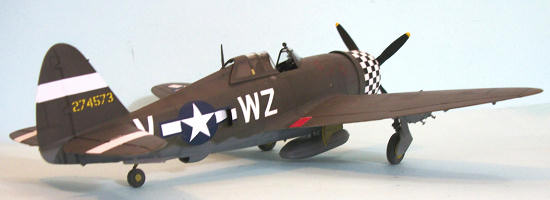 slammed the
throttle into War Emergency Power, turning right as hard as he could to meet the
attacker.
“He had the advantage of speed, altitude and position; my luck
was he wasn’t behind me, and was presented with a tricky firing angle.
He missed and flashed past.
From experience, I was confident I could out-climb and
out-turn him, but more important I could turn on a dime at the top of a
near-vertical climb and give back change; we called that maneuver a ‘stall
turn.’
My chief advantage was that the Jug happened to have the fastest aileron
roll of any fighter, even at low speed.
The maneuver was fairly simple: in a vertical climb at
full power, just before I stalled, I would roll and smoothly apply rudder in the
direction I wanted to go, nurse the stick back to get the nose down, and then
accelerate. I could almost fly back down the air corridor I had ascended.”
As Russell looked over his shoulder, he saw the Bf-109
doing the same.
“I waited for him to be forced into a turn; he committed to a
right turn as I had hoped.
I was right at the stall and I rolled left to meet him
head-on.
I looked opposite and he was just completing his turn as I pulled out
ahead of him.
We passed again without firing and I yanked back straight up
again.
I watched over my shoulder; he was forced to match my climb or run.
Up we went.
I waited and watched him opposite me and significantly
lower.
Finally he committed to a left turn.
I turned opposite and beat him out.
Now it was my turn as I maneuvered into position 45
degrees off his tail.
He rolled into a steep left turn trying to out-turn me,
but I was only 150 yards behind him. Like lining up quail, I pulled my sight
through him, sensed my lead and pulled the trigger.
I gave him a two-second burst that hit his cowling.
My next burst dwindled into ‘pop - pop’ as seven of my
eight guns jammed! He was less than 50 yards away; to avoid over-running him I
pulled up steep and rolled down on him, but he was out of the fight.
I had to worry about the others that were still after
us, but my gun camera film later confirmed he was on fire.
As I rolled out to meet the next ones, we were suddenly
alone in the sky.”
Joining Brown and his wingman Smith, Russell was glad to
head home. A moment later the four were bounced again.
As they broke right, the Germans dove away straight
down.
Russell recalled, “Why they decided not to take us on I’ll never know;
Quince was low on ammunition and I only had one gun working, so I wasn’t unhappy
to see them go.”
Over the Channel, Russell realized his RAF-issue helmet was
soaked wet with sweat.
slammed the
throttle into War Emergency Power, turning right as hard as he could to meet the
attacker.
“He had the advantage of speed, altitude and position; my luck
was he wasn’t behind me, and was presented with a tricky firing angle.
He missed and flashed past.
From experience, I was confident I could out-climb and
out-turn him, but more important I could turn on a dime at the top of a
near-vertical climb and give back change; we called that maneuver a ‘stall
turn.’
My chief advantage was that the Jug happened to have the fastest aileron
roll of any fighter, even at low speed.
The maneuver was fairly simple: in a vertical climb at
full power, just before I stalled, I would roll and smoothly apply rudder in the
direction I wanted to go, nurse the stick back to get the nose down, and then
accelerate. I could almost fly back down the air corridor I had ascended.”
As Russell looked over his shoulder, he saw the Bf-109
doing the same.
“I waited for him to be forced into a turn; he committed to a
right turn as I had hoped.
I was right at the stall and I rolled left to meet him
head-on.
I looked opposite and he was just completing his turn as I pulled out
ahead of him.
We passed again without firing and I yanked back straight up
again.
I watched over my shoulder; he was forced to match my climb or run.
Up we went.
I waited and watched him opposite me and significantly
lower.
Finally he committed to a left turn.
I turned opposite and beat him out.
Now it was my turn as I maneuvered into position 45
degrees off his tail.
He rolled into a steep left turn trying to out-turn me,
but I was only 150 yards behind him. Like lining up quail, I pulled my sight
through him, sensed my lead and pulled the trigger.
I gave him a two-second burst that hit his cowling.
My next burst dwindled into ‘pop - pop’ as seven of my
eight guns jammed! He was less than 50 yards away; to avoid over-running him I
pulled up steep and rolled down on him, but he was out of the fight.
I had to worry about the others that were still after
us, but my gun camera film later confirmed he was on fire.
As I rolled out to meet the next ones, we were suddenly
alone in the sky.”
Joining Brown and his wingman Smith, Russell was glad to
head home. A moment later the four were bounced again.
As they broke right, the Germans dove away straight
down.
Russell recalled, “Why they decided not to take us on I’ll never know;
Quince was low on ammunition and I only had one gun working, so I wasn’t unhappy
to see them go.”
Over the Channel, Russell realized his RAF-issue helmet was
soaked wet with sweat.
While Russell had engaged in his turning fight with the Bf-109, Brown had shot down a Bf-109 and an Fw-190, with his score now at ten, he was the group’s third “double ace.” II/JG 26, the Luftwaffe unit they had tangled with, recorded three Bf-109s shot down over the field in addition to the Ju-88 and Bf-110 exploded by strafing, and the further loss of two Bf-109s and an Fw-190 in the following engagement. 8th Fighter Command eventually confirmed four destroyed for Brown, one destroyed and one probable for Russell, and one probable for Russell’s wingman, Orr. Brown was awarded the Silver Star.
By the end of April, Brown had 12 victories and was the
leading ace of the 78th FG.
Following D-Day, the 78th
and the other P-47 units in the 8th
AF joined with the 9th AF in
providing ground support over Normandy and opportunity for air combat dwindled.
Brown managed to score his thirteenth victory in July,
just before his tour expired.
Volunteering for a second tour, he went home for 30
days, returning to Duxford on August 28, 1944, where he took command of the 84th
Fighter Squadron.
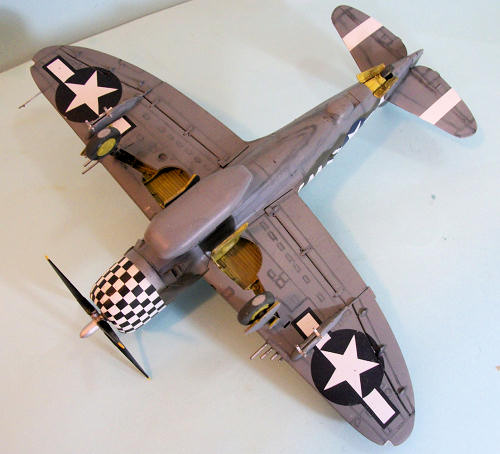 The pace of missions was such that by September 6,
Quince Brown was already on his fifth mission of his second tour, leading 78A
group on a strafing mission to hit Vogelsund Airdrome, near Schleiden, Germany.
Captain Dick Hewitt led 82nd
Squadron as high cover for the mission.
As he later recalled, “I was flying top cover at only
8,000 feet with my four flights and had a good view of what happened when they
hit the target.
After one pass, Major Brown chose to abandon the attack after
being hit.
He pulled away from the airdrome with the rest of the group
behind him and headed towards Schleiden. He must have figured that he might find
a locomotive or two, since Schleiden was a rail center. Once we were over the
town, it was evident from the tell-tale smoke in the rail yard that we had found
a good target.
Major Brown turned toward the smoke and started a pass.
Suddenly, the sky was full of 20mm and
37mm tracers all aimed at Brown’s flight as a flak car embedded in the train
immediately started firing.
As he started his pullout, I heard him call that he’d
taken an engine hit and was baling out.
I saw his ‘chute billow as it opened, and it was only a
moment later that he hit the ground.
Civilians from the nearby train and farmers in the
nearby field surrounded him almost immediately, giving him no chance to escape
into a nearby woods.”
At that point, other flak positions in the town opened
up and the Thunderbolts turned for home.
The pace of missions was such that by September 6,
Quince Brown was already on his fifth mission of his second tour, leading 78A
group on a strafing mission to hit Vogelsund Airdrome, near Schleiden, Germany.
Captain Dick Hewitt led 82nd
Squadron as high cover for the mission.
As he later recalled, “I was flying top cover at only
8,000 feet with my four flights and had a good view of what happened when they
hit the target.
After one pass, Major Brown chose to abandon the attack after
being hit.
He pulled away from the airdrome with the rest of the group
behind him and headed towards Schleiden. He must have figured that he might find
a locomotive or two, since Schleiden was a rail center. Once we were over the
town, it was evident from the tell-tale smoke in the rail yard that we had found
a good target.
Major Brown turned toward the smoke and started a pass.
Suddenly, the sky was full of 20mm and
37mm tracers all aimed at Brown’s flight as a flak car embedded in the train
immediately started firing.
As he started his pullout, I heard him call that he’d
taken an engine hit and was baling out.
I saw his ‘chute billow as it opened, and it was only a
moment later that he hit the ground.
Civilians from the nearby train and farmers in the
nearby field surrounded him almost immediately, giving him no chance to escape
into a nearby woods.”
At that point, other flak positions in the town opened
up and the Thunderbolts turned for home.
The 78th
was hard-hit by the loss of their leading ace, a man who was popular and admired
by everyone. After the war, it was reported that Brown had been shot by a German
civilian, who was later executed in 1947 for the crime. In fact, the story of
the death of the leading ace of the 78th
Fighter Group is far different.
In 2003, Dick Hewitt received a phone call from Mr.
Frank Guth of Schleiden, Germany, who was researching a book about the war as it
had happened in the city.
After telling him the story recounted above, Guth told
Hewitt what had really happened, as recounted by his aunt, a girl of 9 at the
time: the civilians who had surrounded Brown in the field brought him into
Schleiden, planning to turn him over to the Luftwaffe
detachment as a Prisoner of War.
However, before this could happen, two
Waffen-SS troopers took Brown from the civilians.
To the horror of all, one of the troopers then pulled
his pistol and shot Brown in the head in the middle of the town square.
After the war, the crime was reported to the American
occupation authorities, and the two SS men were identified.
In 1947 they were tried as war criminals for shooting a
surrendered prisoner, and hanged.
| THE KIT |
No information provided. I am sure there is a look in the box somewhere on the site. Ed.
| CONSTRUCTION |
As with the F6F-3 Hellcat and SB2C-3 Helldiver I did
earlier this year, the genesis for this project is my having just finished
writing “Aces of the 78th Fighter
Group” for Osprey, which will be published next year.
During the project, I came to know a lot about Quince
Brown from his old fiends Ernie Russell and Dick Hewitt, and the personal
materials provided me by his nephew, Rusty Brown.
Quince Brown is one of the least-known leading American
aces of the war, which stimulated a desire to have a model of his P-47D-2, “Okie.”
This is what I said about building the kit way back in
2003 when it first came out:
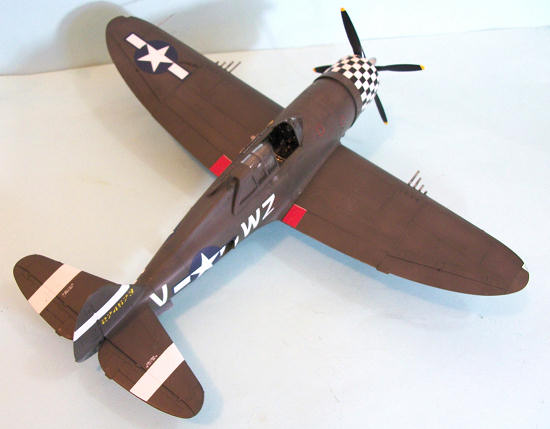 Hey, it's a Tamiya kit.
Unless you are too illiterate to read the instructions,
and too ham‑fisted to touch the parts without breaking them, it is impossible
for you to not "get it right" by following the instructions.
Hey, it's a Tamiya kit.
Unless you are too illiterate to read the instructions,
and too ham‑fisted to touch the parts without breaking them, it is impossible
for you to not "get it right" by following the instructions.
First, I painted all the interior parts for the cockpit and the
engine area, wheel wells, etc., and set those aside to dry for the day; my only
departure from the kit instructions was to paint the main gear legs Olive Drab,
since that is the callout in the Profile Publication "P‑47 Camouflage and
Markings," which quotes from the original painting instructions.
That evening, I sat down and followed the instructions, and had
the kit assembled in about 2 hours of enjoyable work. There are no problems to
worry about, given that the production design of the kit is as good as the
Corsair and the Wildcat ‑ what more needs be said?
The big difference with this kit was that after looking
at every picture I have of 78th FG
P-47s - and I have a lot of them now - I did not find any of P-47s parked with
the flaps down.
I queried Dick Hewitt about this and his response was that a
pilot could generate “a lot of trouble” with everyone from his crew chief on up
if he didn’t retract the flaps immediately after touchdown.
Thus, on this kit, the flaps are up.
It’s nice that Tamiya has designed this kit to allow
either option, since with most kits (like the Corsairs), doing anything other
than what it is designed for is damned difficult.
Additionally, I had to modify the cowling flaps since
Tamiya has produced a P-47D-10 to D-22 Thunderbolt, and “Okie” was an early
P-47D-2.
I cut off the lower flaps from the open cowling flaps part, then cut off
flaps from the other part and substituted them to get the “all square” look of
the early P-47D.
| COLORS & MARKINGS |
Doing “Okie” is difficult, since there was only ever one
decal sheet produced with these markings, a sheet done by SuperScale a good 25+
years ago.
Fortunately, I have portions of that sheet still in the decal
dungeon (never ever throw away anything!), and thus I thought I had the personal
markings for Okie.
Unfortunately, the markings did not include either the proper victory markings - a series of small swastikas - or the mission markings, what was eventually a fairly large collection of brooms painted in yellow on the left fuselage aft of the cowling and ahead of the cockpit. Search as I did through the dungeon, there was nothing there that could be substituted for either the swastikas or the brooms. For awhile, it appeared I would have to make another choice of airplane to model. (Superscale 48-879 includes these markings. Ed)
Fortunately, I ran across a photo of “Okie” in what is
likely May 1944 (by the scoreboard) when she had become “Okie I” and been
replaced by Brown’s newer “Okie II,” a P-47D-22 in natural metal.
By this time, the old bird had been modified with the
underwing pylons, and had the group insignia of the black-and-white checkerboard
cowl.
Most importantly, those mission markings had been painted out and the
scoreboard had been changed to a long black rectangle with German crosses
outlined in white.
I could create that scoreboard by modifying decals from
a Lifelike Decals P-47 sheet.
Additionally, “Okie” had finally had her national
insignia painted on properly.
The airplane had arrived in late May, 1943, when the US
national insignia was the circle-star.
Then in July 1943, the white bars had been added with a
red surround, but “Okie” was one of many airplanes in all theaters to have only
the white bars on the upper wing and fuselage.
The lack of blue surround on the fuselage and upper wing
insignia 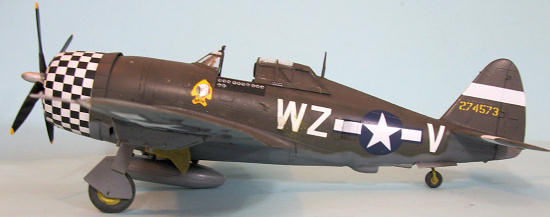 stayed
that way until at least March 1944, according to photos that can be dated with
the scoreboard; interestingly the very large lower wing insignias did have the
surround from the beginning, according to a photo taken that shows the underside
of the wing with what may be the red surround and the rear fuselage, which still
lacks the surround.
But by May 1944, “Okie” had her insignias all proper.
The ID letters had changed from “WZ-J” to “WZ-V” since “Okie
II” now carried “WZ-J”.
Additionally, while nearly every other earlier
Thunderbolt in the ETO had been re-equipped with the Curtiss-Electric “paddle
blade” prop, “Okie” still flew with the old “toothpick” prop. Also, by that
point, the paint job was badly weathered from high-altitude UV sun-fading; this
meant that the model could end up looking interesting.
stayed
that way until at least March 1944, according to photos that can be dated with
the scoreboard; interestingly the very large lower wing insignias did have the
surround from the beginning, according to a photo taken that shows the underside
of the wing with what may be the red surround and the rear fuselage, which still
lacks the surround.
But by May 1944, “Okie” had her insignias all proper.
The ID letters had changed from “WZ-J” to “WZ-V” since “Okie
II” now carried “WZ-J”.
Additionally, while nearly every other earlier
Thunderbolt in the ETO had been re-equipped with the Curtiss-Electric “paddle
blade” prop, “Okie” still flew with the old “toothpick” prop. Also, by that
point, the paint job was badly weathered from high-altitude UV sun-fading; this
meant that the model could end up looking interesting.
I first painted the cowling with Tamiya “flat White” and then masked it off. I then pre-shaded the model with airbrushed flat black, then applied Tamiya “Neutral Grey” to the lower surfaces. Since “Okie” was an early-1943 production airplane, she was painted with OD 41, the prewar color, a green-base olive drab. I created that with a mixture of Tamiya “Olive Drab” and Tamiya RAF “Dark Green”. Once that had been applied, I added in some Tamiya “Khaki Drab” and post-shaded the model. I then added in some Tamiya “Flat Red” and thinned the paint to about 60% thinner, and went over the upper surfaces, with concentration on the wings, horizontal stabilizer and upper fuselage, then I added in some Gunze-Sangyo “Violet” and thinned the paint to about 70% thinner and went over the entire upper surfaces. This gave me the “UV sun-faded” look. I then took some OD 43 (brown-base Olive Drab) and went over the area of the left forward fuselage where the mission markers had been painted out. When all this was finished I unmasked the cowling and gave the model an overall coat of Xtracrylix Gloss Varnish.
The markings were done using the kit decals for the
underwing insignia, with national insignia for the fuselage and upper wing, and
the white tail ID stripes, from a Lifelike Decals sheet.
The checkerboard was done with decals from a Cutting
Edge decal sheet.
I used the original SuperScale decals for the Arrowhead,
the “WZ” of the ID letters, and the serial number on the tail.
The “V” came from another old SuperScale sheet.
I used the yellow numerical markings for the prop blades
but left off the Curtiss logo, since “Okie” didn’t have the logo on the prop.
When all was set I washed the model to get rid of solvent residue and gave the model a coat of a mixture of Xtracrylix “Satin” and “Flat” varnishes, to come up with a smooth surface that looked like it had been polished with beeswax (something that was done with all the old camouflaged P-47s of the 84th squadron throughout the period of their service).
| FINAL CONSTRUCTION |
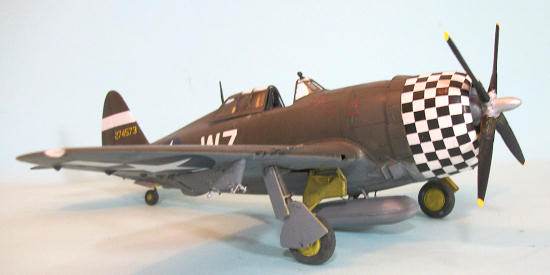 The P-47 doesn’t have a lot of exhaust staining since
the exhaust went out the turbo discharge gate on the lower rear fuselage.
However, there would have been a fine smear of oil aft
of the cowling, which I did by airbrushing thinned Tamiya “Smoke”.
Photos show a bit of “scuffing” along the wing below the
cockpit and some “dings” on the wing leading edges, which I did.
The P-47 doesn’t have a lot of exhaust staining since
the exhaust went out the turbo discharge gate on the lower rear fuselage.
However, there would have been a fine smear of oil aft
of the cowling, which I did by airbrushing thinned Tamiya “Smoke”.
Photos show a bit of “scuffing” along the wing below the
cockpit and some “dings” on the wing leading edges, which I did.
The 78th
started using the 165-gallon “flat tank” in April 1944 when they flew “Thunderbomber”
missions, so I used that tank with the underwing racks.
Once he got “Okie II,” Brown used “Okie I” mostly for
ground attack missions (not wanting to get the pretty new silver airplane nicked
with flak holes).
I attached the landing gear, and unmasked the canopy,
placing it in the open position.
| CONCLUSIONS |
So, now I have a singular model of a lesser-known but
very singular pilot I feel I have come to know over the past several months of
studying him and his compatriots.
The Tamiya kit is still one of the best 1/48 kits ever
created.
I used no putty or surfacer on the project.
Everything fits precisely.
This is a perfect kit for someone just starting out or
just returning to the hobby, but it will spoil you for everything else.
September 2012
Review kit courtesy of my wallet.
If you would like your product reviewed fairly and fairly quickly, please contact the editor or see other details in the Note to Contributors.